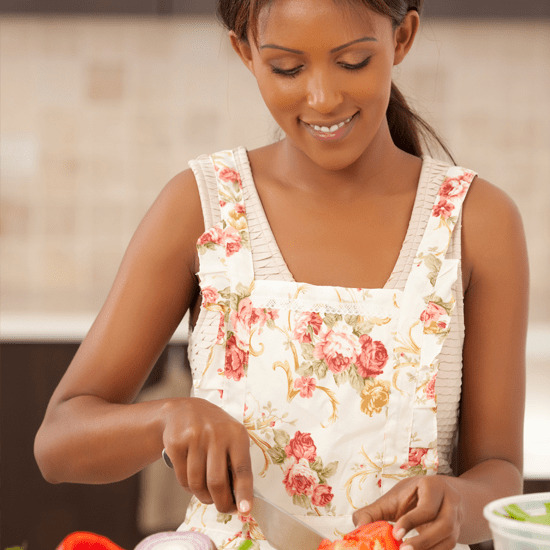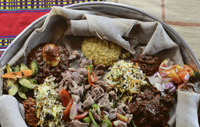One of the oldest continuous cultures in the world and the only African country never to be colonized by Europe, Ethiopia or Abyssinia as it used to be called has fascinated the world since the days of the irresistible Queen of Sheba. Many believe she was from Ethiopia, or just across the Red Sea in present day Yemen.
These days, it’s Ethiopian cuisine that so many of us find irresistible. Spicy, flavorful and healthy, its partly influenced by its neighbors like Sudan and Eritrea, as well as Italy, which occupied the country briefly 75 years ago. Its delightful uniqueness however centers on injera, the spongy sourdough flatbread used to scoop up a variety of bean, meat and vegetable stews and sauces. Injera is naturally vegan and gluten-free, as are many Ethiopian dishes, making this cuisine a particular favorite for those with dietary restrictions and preferences.
Many if not most Ethiopian dishes are perfectly suited to injera, so forks, knives and spoons are rarely needed. It’s all about using your hands!
Here’s a rundown of dishes you’ll want to try out at an Ethiopian restaurant or in your own kitchen:
- Shiro is Ethiopia’s version of curry, a chickpea powder cooked with spicy chili-based red berbere sauce.
- Berbere sauce includes chili peppers, garlic, ginger, basil and other delicious ingredients.
- Wot is a stew or curry prepared with chicken, beef, lamb or vegetables, and fixed with berbere and clarified butter.
- Atkilt Wot is a delectable cabbage dish mixed with carrot and potatoes in a light sauce.
- Doro Wot is the most popular traditional dish in Ethiopia, made with chicken, and sometimes, hard-boiled eggs.
- Azifa: A green lentil salad you can eat on its own or mixed in with injera.
- Fasolia, whose name harkens back to the Italian that inspired it, is a salad made of string beans, carrots and onions.
- Ful medames is a rich Egyptian dish popular in Ethiopia consisting of mashed fava beans, oil, cumin, parsley and lemon juice.
- Sambusa, like middle eastern sambusak, is a fried dough pastry with meat or lentil filling
- Chechebsa: one of Ethiopia’s traditional breakfast dishes and one of the few eaten with a spoon. Resembling a pancake, chechebsa is covered with spices and butter.
Coffee is also central to Ethiopian cuisine. In fact, it’s believed that drinking coffee actually originated in Ethiopia. Ethiopians partake in an elaborate coffee ceremony after meals, including espresso usually served with sugar or salt.
What’s your favourite or most intriguing Ethiopian dish? Care to make your own? Share your love and curiosity about Ethiopian cuisine in the Shop Talk Blog community forum!
Did you know: Gursha means love
Ethiopians often roll some injera and gently feed it to family or friends. Gursha, as this tradition is called, is a sign of strong friendship or love. (Source)



Very informative i learned a lot.
Daniel
I believe that this is the first time i have seen information about Ethiopian food so well..
So incredible to read about Ethiopian food. More than fifty years ago I was a Peace Corps Volunteer there. The delicious and healthy food, and the intelligent, creative people changed my life. Lucky me!
wao this looks really yammy.
My family and I will try a dish. And have it your way.Thank you. Your culture sounds very interesting and your meals sound awesome.
I just Love Ethiopian food, I introduced my husband to this delicacy and he loves it! My older brother and I used to have a friend from Ethiopia and, he was kind and nice enough to treat us to an Ethiopian restaurant in town “Cambridge Ma”. And since then I’ve been loving it.
Josie
I would really like to try all these dishes.
” ETHIOPIA WAS ONLY AFRICAN NATION THAT WAS NEVER COLONIZED BY
A EUROPEAN NATION.”
ITALY WAS THERE OCCUPYING IT FOR A NUMBER OF YEARS.
I think I would like Wot the best
Having lived kn Addis Abba for 3 years and having had those dishes and learned to love them. Especially injera and doro wot – I would love to have the receipt of those dishes. It has been 44 years since I was there. Could you please send me the receipt for those dishes. Thanks.
Love to try some new healthy foods,looking for an Ethiopian restaurant in Baltimore city, a nice September birthday gathering.
My first overseas assignment in the US Army was in Asmara, Eritrea. I met, dated,
and married an Italian girl who was a wonderful cook. In Eritrea, the combination of
injera and berbere sauce is called zigani ; it is delicious. Over the years, my wife
would cook zigani two or three times a month. I enjoyed reading the above article.
It brought back fond memories of the best assignment I ever had. Blessings on you
all!
Dear blogger
This my first time to every blog. Just join Shopper Voice. Can’t wait to see what comes next.
Have a good day!
Kim
I think it’s awesome that people around the world participate in different kinds of cooking and that other people from different countries learn to do different kinds of cooking from different cultures around the world that is totally awesome
Would like to learn new recipes for the New year. I chose food from Ethiopia. Looking forward to delicious taste.
Great stuff.
thanks
love it
Ethiopian food article intetesting, never tried, but informative
Looking for new things